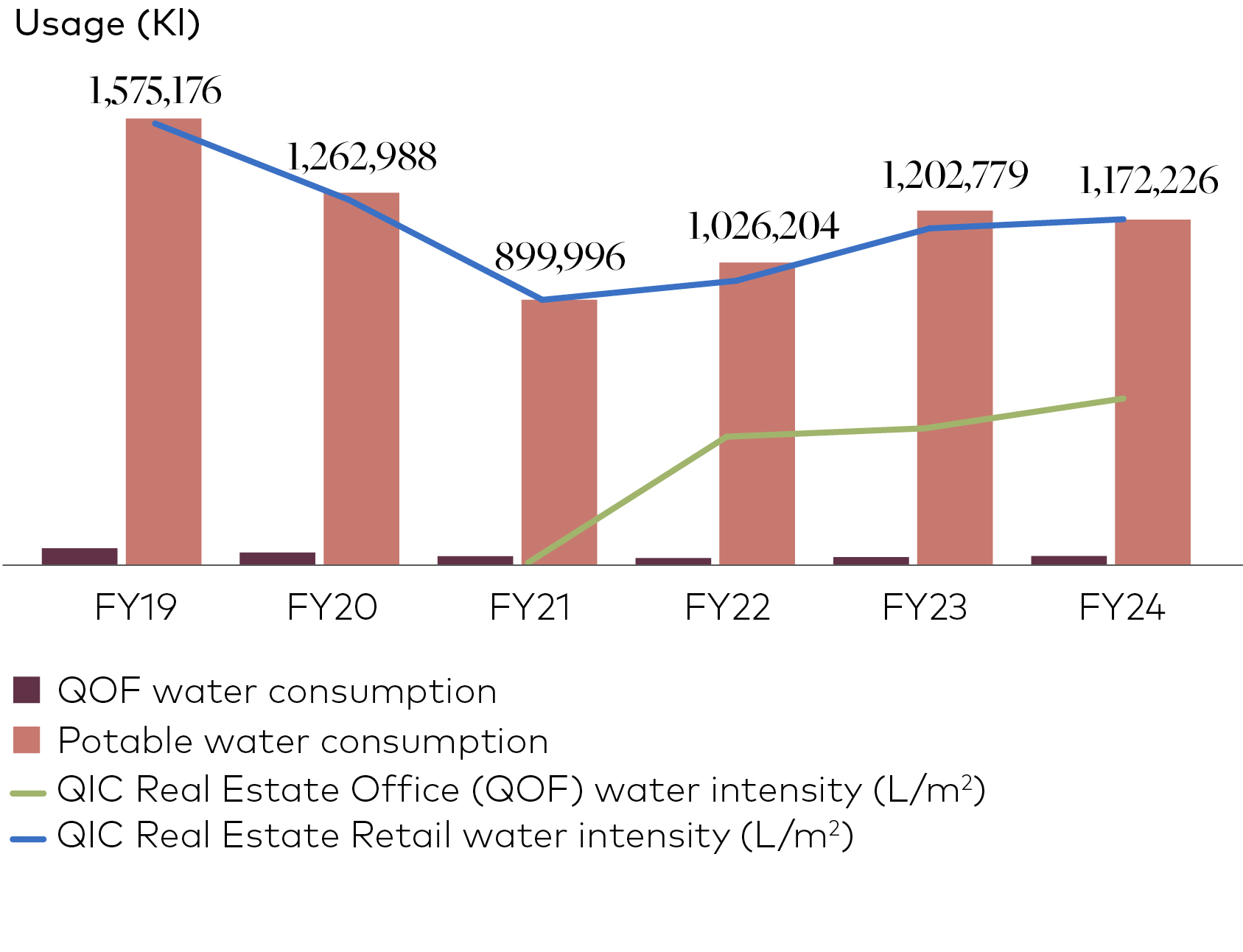
Resource efficiency and circular economy initiatives that contribute to QIC Real Estate portfolio’s long- and short-term ESG objectives are identified and implemented through continuous improvement programs, annual business planning and 10-year capital planning processes. Related initiatives undertaken during FY24 are presented below.
We aim to manage materials in a way that retains their value in a circular economy. We endeavour to recycle as much waste material as possible, with a focus on recycling materials that may be used repeatedly, constantly being returned to the same production cycle, and can be recovered without any consequent hazardous material build-up in the environment (A-Grade waste materials). We also look to reuse and repurpose existing materials and procure products that contain a high level of recycled content within our development projects.
In FY24, we continued to improve our waste management processes and updated existing operational waste management plans across our retail assets to capture further performance improvements made during FY23, and identify additional future opportunities for implementation. These plans are live documents, helping us standardise our waste management practices across the portfolio and identify additional resource recovery initiatives for implementation.
This year, we prioritised the expansion of organic waste recycling across all assets that did not already have it in place. This initiative has driven a considerable increase in the diversion of organic waste from landfill. By standardising the measurement of this across our assets in FY25, we expect to obtain more granular data on the impact this is having on our portfolio-wide waste management performance.
We also completed an exhaustive tender process for a new portfolio-wide national waste management contract. Our goal was to find a waste partner aligned with our objectives who we could effectively collaborate with to maximise our waste recycling and diversion from landfill performance through the implementation of improved resource recovery and waste management policies and practices. Under the new contract, we seek to upgrade our waste management infrastructure, roll-out additional recycling streams and standardise our waste/recycling related communications and signage across our portfolio. The contract is due to commence in November 2024 and includes waste management performance KPIs aligned to our waste recycling and diversion from landfill targets, which will drive improvements in our waste management performance in future years.
In FY25, we plan to improve our measurement of waste generation and recycling outcomes from tenancy defits and fitouts across the portfolio. We hope to standardise our data collection and reporting, and collaborate with external suppliers to identify new resource recovery initiatives to enhance our year-on-year diversion from landfill rates.
We aim to minimise our potable water use wherever possible by improving the efficiency of water-using equipment and optimising our building services to minimise unnecessary water use.
Our water meter upgrade program continued throughout FY24. Almost 850 water meters have been installed and integrated into the CIM PEAK Platform as part of this project, enabling advanced consumption reporting and leak detection through sophisticated algorithms. These insights have also enabled us to improve tenant awareness of water consumption, helping to further our sustainability efforts. The second tranche of our water meter program is planned for roll out during FY25.
The FY24 total waste diversion from landfill rate of 37% remained flat with our FY23 diversion rate. COVID-19 related lockdowns may have temporarily increased waste diversion rates in FY20, FY21 and FY22 in Victoria, the ACT and New South Wales due to lower customer visitation and reduced retailer waste generation because of extensive store closures. We expect our performance to continue improving as additional waste diversion initiatives are implemented throughout FY25 and beyond as part of the national waste contract implementation.
In FY22, we also began tracking the diversion from landfill of ‘A-Grade’ waste material. This is material that can be used repeatedly, constantly being returned to the same production cycle, and can be recovered without any consequent hazardous material build-up in the environment (e.g. paper/cardboard, glass, metal, organics, etc). This year, we achieved an A-Grade operational waste diversion rate of 34% across the portfolio, representing a performance improvement of ~1%.
Figure 8: QIC Real Estate portfolio annual waste diversion rate, FY19-FY2429
Water use during FY24 decreased by ~12% compared to FY23. We expect our water use to reduce in FY25 and beyond as we continue our digital water meter roll out project. The meters will be connected to the CIM Peak platform and improve our ability to monitor the water use of key plant and equipment, identify and address leaks and abnormal usage spikes quickly, and further separate tenant water use from common area usage.
Figure 9: QIC Real Estate portfolio annual water use, FY19-FY2430
29 Waste and recycling data covers QIC Real Estate’s retail and office portfolios. QIC Real Estate does not provide waste management services for industrial or commercial assets held within the QIC Australia Core Plus Fund.
30 Water use data covers QIC Real Estate’s retail, office, and industrial portfolios.





